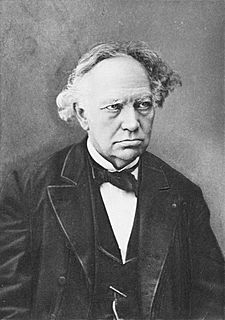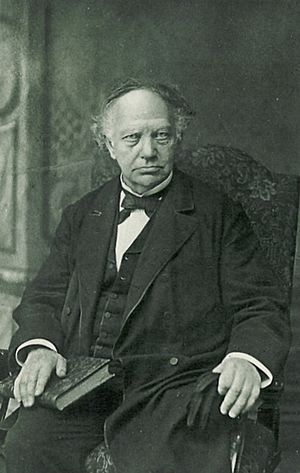Charles Hermite facts for kids
Quick facts for kids
Charles Hermite
|
|
|---|---|

Charles Hermite
|
|
| Born | 24 December 1822 |
| Died | 14 January 1901 (aged 78) |
| Nationality | French |
| Alma mater | Collège Henri IV, Sorbonne Collège Louis-le-Grand, Sorbonne |
| Known for | Proof that e is transcendental Hermitian adjoint Hermitian form Hermitian function Hermitian matrix Hermitian metric Hermitian operator Hermite polynomials Hermitian transpose Hermitian wavelet |
| Scientific career | |
| Fields | Mathematics |
| Institutions | |
| Doctoral advisor | Eugène Charles Catalan |
| Doctoral students | Léon Charve Henri Padé Mihailo Petrović Henri Poincaré Thomas Stieltjes Jules Tannery |
Charles Hermite (French pronunciation: [ʃaʁl ɛʁˈmit]) FRS FRSE MIAS (24 December 1822 – 14 January 1901) was a French mathematician who did research concerning number theory, quadratic forms, invariant theory, orthogonal polynomials, elliptic functions, and algebra.
Hermite polynomials, Hermite interpolation, Hermite normal form, Hermitian operators, and cubic Hermite splines are named in his honor. One of his students was Henri Poincaré.
He was the first to prove that e, the base of natural logarithms, is a transcendental number. His methods were used later by Ferdinand von Lindemann to prove that π is transcendental.
Life
Hermite was born in Dieuze, Moselle, on 24 December 1822, with a deformity in his right foot that would impair his gait throughout his life. He was the sixth of seven children of Ferdinand Hermite and his wife, Madeleine née Lallemand. Ferdinand worked in the drapery business of Madeleine's family while also pursuing a career as an artist. The drapery business relocated to Nancy in 1828, and so did the family.
Hermite obtained his secondary education at Collège de Nancy and then, in Paris, at Collège Henri IV and at the Lycée Louis-le-Grand. He read some of Joseph-Louis Lagrange's writings on the solution of numerical equations and Carl Friedrich Gauss's publications on number theory.
Hermite wanted to take his higher education at École Polytechnique, a military academy renowned for excellence in mathematics, science, and engineering. Tutored by mathematician Eugène Charles Catalan, Hermite devoted a year to preparing for the notoriously difficult entrance examination. In 1842 he was admitted to the school. However, after one year the school would not allow Hermite to continue his studies there because of his deformed foot. He struggled to regain his admission to the school, but the administration imposed strict conditions. Hermite did not accept this, and he quit the École Polytechnique without graduating.
In 1842, Nouvelles Annales de Mathématiques published Hermite's first original contribution to mathematics, a simple proof of Niels Abel's proposition concerning the impossibility of an algebraic solution to equations of the fifth degree.
A correspondence with Carl Jacobi, begun in 1843 and continued the next year, resulted in the insertion, in the complete edition of Jacobi's works, of two articles by Hermite, one concerning the extension to Abelian functions of one of the theorems of Abel on elliptic functions, and the other concerning the transformation of elliptic functions.
After spending five years working privately towards his degree, in which he befriended eminent mathematicians Joseph Bertrand, Carl Gustav Jacob Jacobi, and Joseph Liouville, he took and passed the examinations for the baccalauréat, which he was awarded in 1847. He married Joseph Bertrand's sister, Louise Bertrand, in 1848.
In 1848, Hermite returned to the École Polytechnique as répétiteur and examinateur d'admission. In 1856 he contracted smallpox. Through the influence of Augustin-Louis Cauchy and of a nun who nursed him, he resumed the practice of his Catholic faith. In July 1848, he was elected to the French Academy of Sciences. In 1869, he succeeded Jean-Marie Duhamel as professor of mathematics, both at the École Polytechnique, where he remained until 1876, and at the University of Paris, where he remained until his death. From 1862 to 1873 he was lecturer at the École Normale Supérieure. Upon his 70th birthday, he was promoted to grand officer in the French Legion of Honour.
Hermite died in Paris on 14 January 1901, aged 78.
Contribution to mathematics
An inspiring teacher, Hermite strove to cultivate admiration for simple beauty and discourage rigorous minutiae. His correspondence with Thomas Stieltjes testifies to the great aid he gave those beginning scientific life. His published courses of lectures have exercised a great influence. His important original contributions to pure mathematics, published in the major mathematical journals of the world, dealt chiefly with Abelian and elliptic functions and the theory of numbers.
In 1858, Hermite showed that equations of the fifth degree could be solved by elliptic functions. In 1873, he proved that e, the base of the natural system of logarithms, is transcendental. Techniques similar to those used in Hermite's proof of e's transcendence were used by Ferdinand von Lindemann in 1882 to show that π is transcendental.
Quotations
I shall risk nothing on an attempt to prove the transcendence of π. If others undertake this enterprise, no one will be happier than I in their success. But believe me, it will not fail to cost them some effort.
Legacy
In addition to the mathematics properties named in his honor, the Hermite crater near the Moon's north pole is named after Hermite.
See also
 In Spanish: Charles Hermite para niños
In Spanish: Charles Hermite para niños
- List of things named after Charles Hermite
- Hermitian manifold
- Hermite interpolation
- Hermite's cotangent identity
- Hermite reciprocity
- Ramanujan's constant


